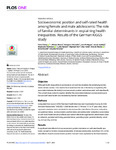2022-04-07Zeitschriftenartikel
Socioeconomic position and self-rated health among female and male adolescents: The role of familial determinants in explaining health inequalities. Results of the German KiGGS study
Rattay, Petra
Blume, Miriam
Wachtler, Benjamin
Wollgast, Lina
Spallek, Jacob
Hoffmann, Stephanie
Sander, Lydia
Herr, Raphael
Herke, Max
Reuter, Marvin
Novelli, Anna
Hövener, Claudia
Objective:
Although health inequalities in adolescence are well documented, the underlying mechanisms remain unclear. Few studies have examined the role of the family in explaining the association between the family’s socioeconomic position and adolescents’ self-rated health. The current study aimed to explore whether the association between socioeconomic position and self-rated health was mediated by familial determinants.
Methods:
Using data from wave 2 of the”German Health Interview and Examination Survey for Children and Adolescents” (KiGGS) (1,838 female and 1,718 male 11- to 17-year-olds), linear regression analyses were conducted to decompose the total effects of income, education, occupational status, socioeconomic position index and adolescents’ subjective social status on self-rated health into direct effects and indirect effects through familial determinants (family cohesion, parental well-being, parental stress, parenting styles, parental obesity, smoking and sporting activity).
Results:
A significant total effect of all socioeconomic position indicators on self-rated health was found, except for income in male adolescents. In female adolescents, more than 70% of the total effects of each socioeconomic position indicator were explained by familial mediators, whereas no significant direct effects remained. The most important mediator was parental well-being, followed by family cohesion, parental smoking and sporting activity. In male adolescents, the associations between income, parental education, the socioeconomic position index and subjective social status were also mediated by familial determinants (family cohesion, parental smoking, obesity and living in a single-mother family). However, a significant direct effect of subjective social status remained.
Conclusion:
The analysis revealed how a family’s position of socioeconomic disadvantage can lead to poorer health in adolescents through different family practices. The family appears to play an important role in explaining health inequalities, particularly in female adolescents. Reducing health inequalities in adolescence requires policy interventions (macro-level), community-based strategies (meso-level) and programs to improve parenting and family functioning (micro-level).
Dateien zu dieser Publikation

